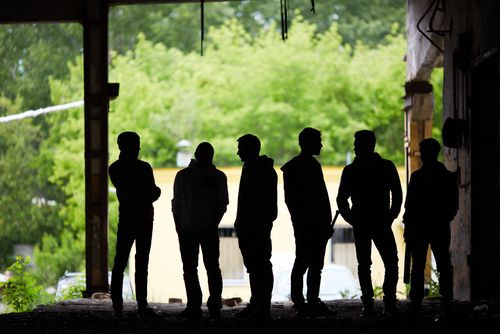A Person's Social Network Predicts Gun Homicides More Than Race, Gang Affiliation, And Poverty

When it comes to your risk of falling victim to gun violence, it turns out it’s both who you know and what you know. That is, if what you know is that who you know is dangerous. Critically, a new study has found that gun homicide victims most often die not as a result of their race, poverty status, or gang affiliation, but by the people they keep in their social groups.
This finding, published in the American Journal of Public Health by Yale University sociologists Andrew Papachristos and Christopher Wildeman, suggests that social circles act as a far better predictor for whether someone faces the threat of homicide than whether they’re male, female, rich, poor, young, or old. Crime, Papachristos notes, functions like a disease. "It's not unlike needle sharing or unprotected sex in the spread of HIV," he said in a statement.
"Generally, you can't catch a bullet from just anyone. Your relationship with the people involved matters.”
This theory counters the perception that stray bullets are constantly ripping through windows in poor neighborhoods. Crime is about “hot people,” Papachristos finds, not “hot spots.” And in the most crime-heavy areas, gun violence among “hot people” is traceable, mappable. In Chicago, where Papachristos has been carrying out his research, the police department has used his data to change policing strategies. Using a technique known as network analysis, the CPD has identified the 20 most at-risk residents in the city and personally knocked on their doors to inform them of the power of their social network and caution them about their risk of death.
The department has traced these 20 residents back to a social network of Chicago gang members nearly 14,000-strong. Through the use of social media, it has also ranked each of these members in terms of how likely they are to be involved as an offender or victim of homicide. "The CPD is using this as a way to reach out to people, rather than just make arrests," noted Papachristos.
Between 2006 and 2011, Papachristos analyzed police and gun homicide records within a six-square-mile zone on the west side of Chicago. He found six percent of the population accounted for 70 percent of the murders, and nearly all of that six percent had prior run-ins with the criminal justice or public health system. Worse, the group faced a 900 percent greater risk for becoming victims of gun homicide than the rest of the city’s population. This suggested to Papachristos that crime worked as a network.
"You could easily identify who the dots are on these network maps and direct the resources accordingly," he said.
The CPD’s efforts have since sought to uphold this suggestion. Rather than flood certain neighborhoods with police officers and blanket an area with protection, breeding the risk of false positives — such is the case with New York City’s “Stop-Question-and-Frisk” program — the CPD took a different strategy. It wanted to find out who the key players were. The department found the majority of people in poverty didn’t commit crimes, nor did many gang members, in fact. That is, unless they were acting as a group.
“These groups have agency. They have structure. And it’s not random. In fact, the big thing there was that they’re inheritable,” Papachristos told GOVERNING magazine. He likened it to the dogma of professional sports: he doesn’t hate the Green Bay Packers for any reason other than blind disdain. And so he forms social bonds over this loyalty. “I don’t actually hate Packers fans, but that sort of structure actually dictates what I wear, who I watch football with, who I tease on Facebook. That’s the same sort of things that gang members inherit, and it leads to murder.”
The CPD’s efforts still need time to fully marinate within the city before the department can draw any conclusions about its success. In the meantime, Papachristos has expanded his study to include the entire city of Chicago, a network of more than 170,000 individuals. He will also begin expanding into other cities in the future, ultimately hoping "to answer the question of how can we police better, smarter, and fairer.”
Published by Medicaldaily.com



























